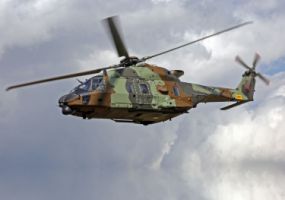Indra unveils its state-of-the-art mission system for next generation aircrafts

November 2, 2021 - Indra is one of the technology companies at the helm of the digitization of defence. The company has just unveiled one of the most advanced tactical mission systems on the market, specially designed to support next-generation aircraft that will operate in highly digitized scenarios against technologically advanced adversaries.
The solution allows commanders to plan and conduct complex operations with impressive accuracy, coordinating the involvement of multiple aircraft, each with its different characteristics and capabilities. It’s a next-generation system that drastically reduces mission complexity in the digital domain and it’s ready to operate in a “combat cloud” environment, facilitating effective decision-making in a streamlined manner.
All the data related to the routes, detected threats and identified targets are entered into the digital mapping, defining the entire tactical combat situation. The system is connected to the Air Force’s command and control and information center to automate a large part of this work.
The military staffs then go on to plan the mission, determining the aircraft to be involved, the entry and exit paths, the potential escape routes, etc. The volume of data and the details provided by the Talium system are huge. It includes variables related to the fuel, weight, crew, flight altitude and speed of each aircraft in the calculations, among many other parameters. It can thus estimate, in real time, whether a mission is feasible and detect any problems that may arise in advance.
It also facilitates the configuration of the communications, establishing the frequencies, channels and data link to be used, centralizing the requirements for all the aircraft and preventing any errors in this highly critical area.
On board the aircraft, the pilot views the entire plan to be executed in Indra’s TDM mission system, the ideal complement for the Talium. Indra’s solutions exchange data in real time via the data link. The commanders can thus monitor the development of the operation and enter any updates into the routes, send orders and make changes to the tactical situation.
The result is much more efficient operations executed in a precise, coordinated and secure manner. All of these skills are essential for survival in highly digitized environments, where information determines superiority over the adversary.
The Talium system also facilitates mission briefing and debriefing. The solution’s logistics subsystem downloads data from the platforms to exploit and share them with the sustainment 4.0 systems in order to make the corrective and predictive maintenance tasks easier.
Talium can manage all kinds of operations via a single system common to all the types of platforms, fleet and mission stages, dramatically reducing the complexity and increasing aircraft availability.
Its open architecture can be integrated into command and control suites, friend-foe identification equipment and flight simulators. All of this makes this solution a key system for decision-making and interoperability with allied forces, complying with the NATO Link-16, Link-22, VMF and NFFI standards, as well as Adat-P3 messaging.
This system is an evolution of Indra’s AMPS mission system currently used by the Spanish Armed Forces’ Tiger and NH90 helicopters. With this evolution Indra is positioning itself at the head of the worldwide development of a key command and control technology, leading the efforts of Europe to ensure its technological autonomy and sovereignty in the area.
Tactical board with VR glasses
Indra has sought to go a step further in the design of the Talium mission system and introduced the use of virtual reality to support the decision-making process.
All the information processed by the Talium system can be viewed in a fully immersive 3D environment by using virtual reality glasses. An advanced tactical board or sandbox is used as a testing, planning and mission analysis environment.
The controls can replicate the operation before it is performed and view it as if it were being executed. They can choose different perspectives to study it, introduce different variables into their analysis and so on.
One of the benefits of this solution is that the virtual scenario can be shared in real time with military commanders located at different bases or deployed thousands of kilometers away. It allows them to meet virtually and interact to plan the operation. This facilitates the coordination of various battalions based in diverse geographical locations that operate with different air platforms but act in a coordinated manner in a conflict zone.
About Indra
Indra (www.indracompany.com) is one of the leading global technology and consulting companies and the technological partner for core business operations of its customers world-wide. It is a world-leader in providing proprietary solutions in specific segments in Transport and Defense markets, and a leading firm in Digital Transformation and Information Technologies in Spain and Latin America through its affiliate Minsait. Its business model is based on a comprehensive range of proprietary products, with a high-value focus and with a high innovation component. In the 2020 financial year, Indra achieved revenue of €3.043 billion, near 48,000 employees, a local presence in 46 countries and business operations in over 140 countries.




